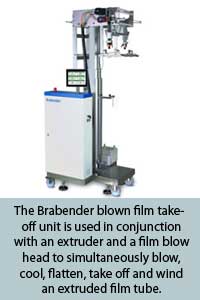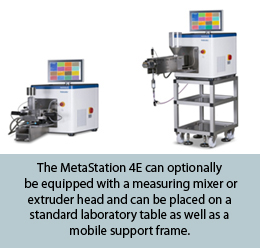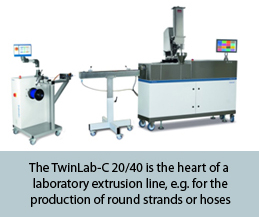PRA Chinese
Rubber Journal Asia Injection Moulding Asia Energy, Oil & Gas Asia
VISIT OUR OTHER SITES:
PRA Chinese
Rubber Journal Asia
Injection Moulding Asia
Energy, Oil & Gas Asia
Brabender showcases new technologies at the K Show
Optimised take-off unit for the production of blown films on a laboratory scale
The new downstream unit for the extrusion of blown films offers user-friendly control, improved accessibility as well as greater flexibility and precision.The take-off unit in conjunction with an extruder with a film blowing head. The extruded plastic polymer is blown into a film tube with a precisely definable diameter, then cooled, flattened, taken off by rollers and wound up. The device is suitable for the production of blown films from thermoplastics, thermoplastics elastomers, biopolymers as well as polyolefins and technical plastics.
What is the blown film take-off unit used for?
Possible applications include final material testing, the development and optimisation of recipes and quality control during production. Since the take-off unit can be used to simulate film production on a small scale, it provides rapid results for testing the processing behaviour of new formulations or materials without having to interrupt ongoing production.
What are the technical advantages of the device?
The blown film take-off unit was designed for particularly flexible film production. The film tube can be precisely adjusted to the desired diameter by precisely controlling the air volume. An optional ultrasonic sensor measures the film width. The inclination of the flattening device can be adjusted to the respective film diameter.

The film thickness is adjusted by simply changing various parameters such as take-off speed, blow-up ratio and bubble height. The roller assembly can be flexibly positioned in height and can be perfectly adapted to a wide range of film thicknesses by means of an electric lifting column. In order to ensure that the film bubble is squeezed even with thicker films, the compressive pressure of the two squeezing rollers can be adjusted pneumatically.
The optional FQA camera system (film quality analyser) allows continuous analysis of film quality without any problems. The touch screen with integrated MetaBridge software makes the control particularly user-friendly and intuitive. Parameters such as support and cooling air volume, working height and winding torque can be easily adjusted via the touch screen.
MetaStation 4E Compact torque rheometer for the laboratory table
The new drive unit for rheological measurements can be used extremely flexibly and provides information on the plasticizing behaviour of different materials, including polymers, ceramic masses, doughs and whipped masses.
The newly developed MetaStation 4E is part of a new generation of particularly flexible and versatile drive units. It was specially designed for laboratory use and allows fast and uncomplicated measurement of the rheological properties of the material to be investigated. In conjunction with an extruder or mixer measuring attachment, the rheometer determines the processing and plasticising behaviour.
The use of the MetaStation 4E for trials has clear economic advantages over machines that are otherwise used in ongoing production. After all, compared to large-volume machines, only a fraction of the raw material quantity is consumed.
Versatile application and combination options
The MetaStation 4E is used in research and development, but also in industry. Numerous application possibilities exist in the fields
 of recipe development, material testing, incoming and outgoing goods inspection, quality assurance during production, process optimization and the production of samples on a laboratory scale.
of recipe development, material testing, incoming and outgoing goods inspection, quality assurance during production, process optimization and the production of samples on a laboratory scale.
The modular design of the torque rheometer makes it possible to perfectly adapt the test setup to the respective requirements of the application. A wide range of extruders and mixer attachments are compatible with the MetaStation 4E. An optional docking station also allows the combination with larger mixers and extruders, which considerably expands the range of applications.
What are the application advantages of the new torque rheometer?
Compared to the older Brabender drive generation, the modern product design is
characterized by a considerably smaller space requirement and a lower weight.
This means that the unit can now be set up directly on the laboratory table. The previously bolted mixer support can now be changed and thus offers a considerable plus in flexibility.
In addition, the device is compatible with the MetaBridge software, which offers not only user-friendly control of several devices, but also fast transmission, evaluation and export of measurement data
TwinLab-C 20/40 Perfect compounding system on a small scale
The compact twin-screw extruder was specially developed for laboratory use and is the ideal companion for the development of recipes and processes.
The TwinLab-C 20/40 can be used in a remarkably wide range of applications, from feasibility studies and material developments in research institutes and industry to analysis of material behaviour during a process and developments in the field of recycling. In addition, the laboratory compounder can be used in quality control and for the production of very small quantities, for example for the production of samples or test specimens.
The laboratory extruder is suitable for compounding samples with or without fillers or additives, e.g. from thermoplastics, technical plastics, thermoplastic elastomers, ceramic materials or metal oxides.
Laboratory instrument with high savings potential
The advantages of laboratory-scale compounding are obvious: the sample quantities are many times smaller than would be the case on a production machine. The use of materials remains low, which is particularly important with expensive or difficult to obtain materials. The disposal costs for test materials are also lower.
Another significant advantage is that the ongoing production process does not have to be interrupted for tests to be carried out, which saves considerable downtime costs. Furthermore, due to its compact design and low throughput rates, the test setup on the laboratory compounder can be adapted quickly and easily if required, for example if a recipe needs to be changed.
The TwinLab-C 20/40 offers the greatest possible flexibility for various applications, including a wide range of die heads and modular screws. The tests can be performed with different L/D ratios. The various openings can be flexibly equipped with dosing systems, thermocouples, pressure transducers, liquid/gas pumps or a vacuum pump.
What can be measured or analysed with the TwinLab-C 20/40?
Pressure sensors, thermocouples and the motor voltage are used to measure material temperature, material pressure and the load or torque. In addition, the residence time of the material in the extruder and optionally the viscosity of the product are determined.

The measured values provide information about the relationship between the extruder settings and process parameters and the resulting product properties. In addition, the horizontally hinged liner allows the evaluation of the process and the selected screw configuration. This information can be used to efficiently optimize a process or product.
The measurements are carried out in a user-friendly manner using the web-based MetaBridge software via a touch screen. The software allows multiple users to access the measurement results from different locations and end devices.
(PRA)
Subscribe to Get the Latest Updates from PRA Please click here
©2019 Plastics and Rubber Asia. All rights reserved.

©2019 Plastics and Rubber Asia. All rights reserved.
Home Terms & Conditions Privacy Policy Webmail Site Map About Us
























